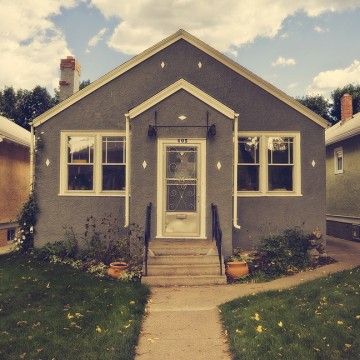Heat loss: Portland Housing Stock’s Insulation Issues
Thursday, September 04, 2014

Photo Credit: krystian_o via Compfight cc
We closed on our house in June of 2001. It was hot that summer, and our first night in the house was like trying to sleep in a cremator. When we demolished the kitchen we discovered why. There was nothing in the walls, between the siding and the framing, where insulation should have been, except a few crumpled up newspapers from 1952. But, fools that we were, we had no extra money in our budget, and no plan to upgrade our insulation. Our plan was only paint, re-finish floors, update the kitchen and bath. And naturally, when it came to heating our house that winter, we paid the price.
If you were to build a new house today, insulation would be a relatively simple part of the building process. Walls are framed with wooden 2x6s and then batt insulation -- long thin pieces of fiberglass or fabric material -- is installed between the siding and the interior walls. Pretty simple, at least in theory. But for our old Portland homes, retrofitting them with insulation becomes much more problematic, and can have an impact on how you value a house.
Take for instance the attic. Most homes built before 1920 had no insulation in the attic at all. If you crawl into your attic space right now, I doubt you’ll find the minimum city code requirement on new construction, which is 12-18 inches of insulation. And unless you’ve remodeled recently, it’s unlikely there’s anything in your walls, either.
Why insulation?
So why do you need to worry about this? Put simply, insulation resists heat loss. Do you remember your high school science class? Insulation is the real world reflection of those transcendental laws of thermodynamics you learned way back then. In essence, heat flows out of a system if there is no resistance to hold the heat in: If there is nothing besides some flimsy crumpled up newspaper in your walls, then the heat your furnace cranks out will quickly spill outside into the cool Oregon evening.
Of course, once you’ve decided you need insulation, there are more decisions to make. Insulation comes in many different materials: fiberglass is most common, as well as rigid styrfoam. but I’ve seen cellulose (ground up newspaper) and even recycled blue jeans used for insulation. Each type of insulation is categorized by an “R” value. R represents resistance, or how much heat the material will resist losing at a certain temperature, over time. The higher the R number, the better the insulation.
That’s why when considering what to do in your old home, it’s important not to follow my lead and just wade into house-buying or redecoration without thoughts of insulation.
It’s worth getting an evaluation of how much energy you’re losing, and Energy Trust of Oregon can recommend several contractors that will come in and charge you $500 to do a comprehensive energy test (many of these energy efficiency programs are state and federally tax deductible). The test involves a blower door test, where the contractor sets up a big fan at your front door, seals the enclosure, and then measures how much air is transferred out of your house. While the fan is moving, the contractor will walk around the house using a smoke tester, to find areas where air is moving freely, and therefore heat is being lost. He or she will also use an infrared camera to look at your walls and windows, to see what areas are allowing the most heat transfer.
Mold growth
Like most things with an old house, solving one problem often creates another unintended consequence. With our hefty annual rainfall here in Portland, we need to be aware of mold growth, which can bring on a whole host of health problems. As you know from turning on your furnace every fall, moisture evaporates with heat. If your walls are lined with insulation that resists heat transfer, then it will hold moisture in your house and without proper ventilation, mold will start to appear. The more you insulate, the more mold becomes a problem.
This is a all worth bearing in mind when considering what R-value you want for your house. It turns out the highest rating may not always be the best option. A building is a system that must breathe to keep indoor air quality high. There are vents that carry away moisture, carbon monoxide and other toxic gases produced when heat sources combust (your furnace, hot water heater and dryer are all sources of toxic gases.) The more you increase your insulation, the more ventilation you’re going to need.
In the end, Andy and I opted to insulate the walls that were already open from the projects we’d planned to do. So parts of my kitchen and bathroom are well insulated, but if you waved an infrared camera inside the rest of my house, you’d see red spots of high heat transfer. And that is typical of most houses in Portland, and pretty obvious if you sit in the wrong place on a cold winter’s night. I wouldn’t recommend it!
Claire Paris is the Principle Broker at Paris Group Realty LLC (Portland, Oregon).
Home Page Photo Credit: -mtnoxx- via Compfight cc




Follow us on Pinterest Google + Facebook Twitter See It Read It